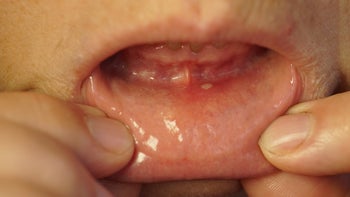
9 Maxalt Side Effects You Should Know About
Key takeaways:
Common Maxalt (rizatriptan) side effects include weakness, dizziness, and drowsiness. Nausea and chest or jaw pain are also possible. Most of the time, you can manage these side effects at home, and they’ll go away as Maxalt wears off.
Rare, but serious Maxalt side effects include serotonin syndrome, heart problems, or stroke. Get emergency medical help if symptoms of these side effects appear after taking Maxalt.
If you take Maxalt more often than prescribed, you may develop medication overuse headaches. Talk to your healthcare provider if you have more than four migraines per month. You may need another treatment option for your migraines.
Access savings on related medications
Table of contents

If you’re one of the millions of people who experience migraine headaches, you may turn to a medication such as Maxalt (rizatriptan) to treat them. Maxalt is a “triptan” medication that constricts blood vessels in the brain to relieve headaches.
Maxalt is usually well-tolerated by most people. But like any medication, it has some possible side effects to be aware of. Let’s take a closer look at what to expect when you take Maxalt.
Maxalt side effects at a glance
Maxalt is generally well-tolerated by most people taking it. The most common Maxalt side effects affected less than 10% of people taking it in clinical trials. These include:
Weakness
Fatigue
Drowsiness
Dizziness
Nausea
Pain or pressure in the neck, throat, or jaw
Tingling sensation on your skin
Dry mouth
Headache
Rare, but serious side effects are also possible with Maxalt. These include:
Heart attack
An irregular heart rhythm (arrhythmia)
Stroke
Vision loss
Medication overuse headaches
Serotonin syndrome
Increased blood pressure
Let’s take a closer look at nine possible Maxalt side effects and what to do if they happen to you.
1. Weakness and fatigue
Weakness and fatigue are among the most commonly reported Maxalt side effects. It may feel harder to perform physical activities. Or you may just have less energy than usual.
It may help to stay hydrated and be sure you’re eating enough throughout the day to keep your energy up. But listen to your body, and rest more often if you need to after taking Maxalt.
This feeling should go away on its own as Maxalt wears off and your migraine goes away. But if it’s bothersome for you or doesn’t improve, be sure to let your healthcare provider know. A lower dose of Maxalt or a different migraine medication may be a better option for you.
2. Drowsiness
Another common side effect of triptans such as Maxalt is drowsiness. It’s best to hold off on driving or other activities that require alertness after taking Maxalt until you know how it affects you. Alcohol and other medications could make drowsiness worse. So, it’s best to avoid combining them with Maxalt unless your healthcare provider tells you it’s OK.
Like fatigue, drowsiness should go away as Maxalt’s effects wear off. But if it doesn’t, let your healthcare provider know.
3. Dizziness
Dizziness is a common symptom of migraine headaches. But it’s also a possible Maxalt side effect. You may feel lightheaded or notice a spinning sensation after taking it.
If you’re feeling dizzy or unsteady on your feet, move slowly and carefully to prevent falls. Try to avoid sudden movements or position changes. And don’t drive or perform tasks that need coordination until you’re certain you can do so safely.
As with most common Maxalt side effects, dizziness should go away on its own. But if it’s severe or gets worse, talk to your provider about options to manage or prevent it.
4. Nausea
Nausea is also a common migraine symptom. But it’s also possible while taking Maxalt. Nausea was reported in up to 6% of people taking Maxalt in clinical trials.
You can take Maxalt with or without food. But if it makes you nauseous, try taking Maxalt with a small snack or meal. You can also try the orally dissolving form of Maxalt (Maxalt MLT). Since you don’t swallow it, this form may be easier on your stomach.
If your nausea doesn’t go away or gets worse, be sure to let your healthcare provider know. You should also touch base with your provider if you vomit after taking Maxalt. They’ll be able to tell you if it’s safe to take another dose.
5. Pain and pressure
You may feel pressure or pain in your chest, neck, or jaw after taking Maxalt. This is a common side effect of triptans. In most cases, the sensation goes away quickly and isn’t anything to worry about.
But if the feeling worsens or doesn’t go away, get emergency care as soon as possible. It could be a sign of something more serious, such as a heart attack. This isn’t common with Maxalt, but it’s always better to be safe than sorry when it comes to chest pain.
6. Overuse headache
Maxalt works well to treat migraine headaches. But if you take it more often than recommended, it can make headaches worse or cause new ones. These are known as medication-overuse headaches (“rebound headaches”).
It’s not recommended to take Maxalt for more than four headaches per month. If you find that you need it more often, talk to your healthcare provider. You may benefit from a medication that helps prevent migraines from happening.
If you’re taking Maxalt as prescribed and your headaches become worse or more frequent, let your provider know. You may need a different medication to treat them. Or there may be something causing the change that needs to be evaluated.
7. Heart problems
As mentioned, in rare cases Maxalt can cause serious heart problems, such as a heart attack. It can also lead to an irregular heartbeat (arrhythmia). Both of these side effects are rare. But they can be life threatening if left untreated.
If you notice chest pain, trouble breathing, or feel faint after taking Maxalt, it could be a sign of a heart-related side effect. Some of these may overlap with migraine symptoms or other Maxalt side effects. But if they seem severe or out of the ordinary for you, it’s best to get emergency help right away.
8. Serotonin syndrome
Serotonin syndrome is another rare but serious Maxalt side effect. It can happen when you have too much serotonin in your body.
You may associate serotonin with mental health conditions, such as depression. But it also plays a role in migraines. Maxalt binds to serotonin receptors, which constricts blood flow in the brain to reduce migraine pain. If you take it along with other medications that raise serotonin levels, the combination could lead to serotonin syndrome.
Examples of other medications that raise serotonin levels include:
Selective serotonin reuptake inhibitors (SSRIs), such as fluoxetine (Prozac) or sertraline (Zoloft)
Serotonin and norepinephrine reuptake inhibitors (SNRIs), such as duloxetine (Cymbalta) or venlafaxine (Effexor XR)
Anti-nausea medications, such as ondansetron (Zofran)
Over-the-counter cough medications that include dextromethorphan (Delsym, Robitussin DM)
Early symptoms of serotonin syndrome include dizziness, nausea, and diarrhea. More severe symptoms include a high body temperature, muscle spasms, and confusion. If you spot symptoms of serotonin syndrome, get emergency medical help right away.
It’s also a good idea to show your current medication list to your healthcare provider and pharmacist before taking Maxalt. They can check for possible drug interactions that could make serotonin syndrome more likely.
9. Stroke
Although rare, Maxalt may raise your risk of having a stroke. It’s worth noting that migraine headaches can also raise your stroke risk. And it’s possible to confuse a stroke with a migraine, since they can have similar symptoms. So if you develop a migraine that feels more severe or different than usual for you, it’s best to get medical help right away.
Stroke symptoms include:
Numbness or weakness in your face, arm or leg, especially on only one side of your body
Confusion
Problems speaking
Problems seeing in one or both eyes
Problems walking
Severe headache
If you spot symptoms of a stroke after taking Maxalt, call 911 as soon as possible.
When should you contact your healthcare provider about Maxalt side effects?
It’s a good idea to let your healthcare provider know about any Maxalt side effects that are bothersome or don’t go away after you take it. Your provider may lower your dose or try a different migraine medication to help lessen the side effects you’re experiencing.
If your headaches become more severe or frequent, that’s another sign to loop in your provider. They may want to add a medication to help prevent them from happening.
If you develop symptoms of severe side effects, such as serotonin syndrome, heart problems, or a stroke, get emergency medical help as soon as possible.
The bottom line
Common Maxalt (rizatriptan) side effects include weakness, dizziness, and drowsiness. Nausea and chest or jaw pain are also possible. Most of the time, you can manage these side effects on your own, and they’ll go away as Maxalt wears off.
If you take Maxalt more often than prescribed, you could develop medication overuse headaches. If you have more than four migraines per month, talk to your provider about other treatment options.
Rare, but serious Maxalt side effects include serotonin syndrome, heart problems, and stroke. Get emergency medical care if symptoms of these side effects appear.
Why trust our experts?



References
Aggarwal, M., et al. (2012). Serotonin and CGRP in migraine. Annals of Neuroscience.
Albieri, V., et al. (2016). Rise of stroke in migraineurs using triptans. Associations with age, sex, stroke severity and subtype. EBioMedicine.
Direct Rx. (2022). Rizatriptan benzoate ODT- rizatriptan benzoate odt tablet, orally disintegrating [package insert].
Organon Limited Liability Company. (2022). MAXALT- rizatriptan benzoate tablet MAXALT-MLT- rizatriptan benzoate tablet, orally disintegrating [package insert].
Was this page helpful?
Compare other migraine drugs
Related Articles
Browse medications
View AllResearch prescriptions and over-the-counter medications from A to Z, compare drug prices, and start saving.












